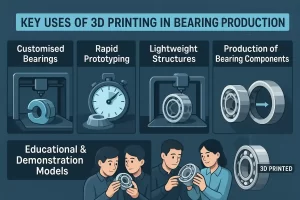
The Role of 3D Printing in Modern Bearing Production
The manufacturing landscape is an ever-evolving space driven by advances in production technology, machine tools, information technology, materials, and products. One of the newest advancements

Toll Free: 1800 3000 6222
Telephone: +91 141 222 3221
Fax: +91 141 222 1926, 222 2259
CIN: U29130WB1946PLC013643
Founded in 1946, National Engineering Industries Ltd (NEI) is India’s leading bearings manufacturer and exporter, renowned for excellence in quality and delivery.

Imagine a tiny, cylindrical roller—a needle roller—nestled snugly within a framework, like a bird in its cage. This setup forms what we call a needle roller bearing, a compact yet powerful component used in machinery across various industries. These bearings come with inner and outer rings that provide support and housing for the needle rollers, ensuring smooth rotation even in tight spaces. Their ability to handle heavy loads in small areas makes them a go-to choice in everything from cars to airplanes.
| Products | Principal Dimensions | Basic Load Ratings | |||
|---|---|---|---|---|---|
| Dynamic | Static | ||||
| d [mm] | D [mm] | B [mm] | C [kn] | Co [kn] | |
| CV15x19x7.8XS | 15 | 19 | 8 | 5350 | 5850 |
| C15x19x10 | 15 | 19 | 10 | 6850 | 8050 |
| C15x19x13 | 15 | 19 | 13 | 8250 | 10200 |
| C15x19x17 | 15 | 19 | 17 | 10900 | 14600 |
| C15x19x24ZW | 15 | 19 | 24 | 14100 | 20400 |
| C15x20x13 | 15 | 20 | 13 | 10100 | 11500 |
| CMJ15X20X15.8XS | 15 | 20 | 16 | 12600 | 15200 |
| C15x21x15 | 15 | 21 | 15 | 11900 | 12500 |
| C15x21x21 | 15 | 21 | 21 | 16500 | 19100 |
| C16x20x10 | 16 | 20 | 10 | 7500 | 9250 |
| C16x20x11 | 16 | 20 | 11 | 8300 | 10500 |
| C16x20x13 | 16 | 20 | 13 | 9050 | 11800 |
| C16x22x12 | 16 | 22 | 12 | 11700 | 12500 |
| CMJ16X22X13 | 16 | 22 | 13 | 12600 | 13900 |
| C16x22x15.8x | 16 | 22 | 16 | 13600 | 15200 |
| C16x22x17 | 16 | 22 | 17 | 14400 | 16400 |
| C16x22x20 | 16 | 22 | 20 | 16000 | 18800 |
| C17x21x15 | 17 | 21 | 15 | 10400 | 14400 |
| C17x21x17 | 17 | 21 | 17 | 11800 | 16900 |
| C17x22x20 | 17 | 22 | 20 | 14700 | 19200 |
| C18x22x10 | 18 | 22 | 10 | 7400 | 9400 |
| C18x22x13 | 18 | 22 | 13 | 8900 | 11900 |
| C18x22x17 | 18 | 22 | 17 | 11700 | 17000 |
| CMJ15X21X16.8X1S | 15 | 21 | 17 | 14900 | 16800 |
| C17x23x17 | 17 | 23 | 17 | 14400 | 16500 |
| C15X18X14 | 15 | 18 | 14 | 7850 | 11600 |



So, what makes needle roller bearings stand out?
Needle roller bearings are the unsung heroes in many machines you encounter daily.
Even high performing bearings require regular check-ups to spot signs of wear or dirt buildup to prevent unexpected breakdowns. By staying on top of maintenance tasks, you can ensure your needle roller bearings keep ticking like clockwork for years to come.
By adhering to a proactive maintenance regimen, users can optimize the performance and longevity of needle roller bearings in their applications.
Needle roller bearings are used to support high radial loads in applications with limited installation space, such as automotive transmissions, heavy machinery, and aerospace systems.
The main difference between cylindrical roller bearings and needle roller bearings lies in their design and dimensions.
Cylindrical roller bearings have cylindrical rollers with a larger diameter-to-length ratio, while needle roller bearings have slender cylindrical rollers with a higher length-to-diameter ratio, allowing them to support higher radial loads in limited-space applications.
Needle roller bearings are commonly made from high-quality alloy steels or stainless steels, which offer excellent strength, hardness, and corrosion resistance. Some specialized applications may require needle bearings made from ceramic materials or polymer composites for enhanced performance and durability.
Needle roller bearings are typically measured based on their bore diameter, outer diameter, and width dimensions. These dimensions are standardized according to international standards, such as ISO and ANSI, to ensure compatibility and interchangeability between different bearing manufacturers.
Follow our latest news and thoughts which focuses exclusively on insight, industry trends, tip news headlines.

The manufacturing landscape is an ever-evolving space driven by advances in production technology, machine tools, information technology, materials, and products. One of the newest advancements

Most of us are aware that bearings are important components used in various mechanical setups, vehicles, household appliances, and more. However, bearings are also proving

We have always heard – bearings are a vital component of industrial machinery, motors, and engines, utilised to minimise friction and allow for smooth rotation.









Copyright © 2023 NEI Ltd. All rights reserved.
Registered Office : 9/1, R. N. Mukherjee Road, Kolkata – 700 001. In case of any queries or grievances, please contact Mr.Tarun Kumar Kabra, Company Secretary.
E-mail: neical@nbcbearings.in Privacy Policy Cookie Policy